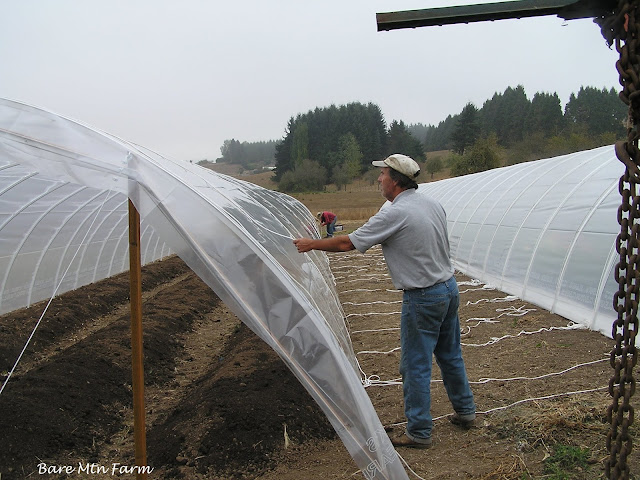Building to the Future and Taking a Risk.
One hoopty do hoop house worked out so well for us this year that we decided to build two more. Actually we wanted four more but there was only time to build two so next year we will build two more. There are several reasons why we build this type of hoop house. Oregon has been slow on the the hoop house grant program and when we talked about getting a grant with the USDA, there were just too many hoops (pun intended) to jump through. Second we are using a field that is not that fertile. For years it has grown grass seed and so the tilth and fertility must be improved. By building a more temporary hoop structure, when the plastic(Skin) needs replacing, we can move the Hoopty Do over new beds that have been prepped for several years. Sort of our own M.A.S.H units (Mobile Agricultural Sustainable Hoop-Houses). And the final reason is that these hoop houses are much more inexpensive to build. We can build 4 or 5 of these houses for the cost of 1 permanent structure 30X98 High Tunnel. Our primary concern is keeping the 40 degree Oregon rains off the beds and plants, snow is not as much of an issue for us. However last year we did have a major snow storm on the first day of Spring, but we were able to scrap the snow off and the hoop houses came through just fine. Our snow event only lasted a couple of days, had it gone on for a week or so, we are not sure how they would have fared. But a major snow event is not the usual around here.
First the square steel pipe is bent.
Its critical to use a level surface to bend the pipe on otherwise the pipe can twist and your bends will not be straight.
Then it is placed on re-bar stakes that are placed in the ground.
We also paint the pipe to coat the metal and prevent rust from occurring and damaging the plastic.
The plastic skin is attached to a post hanging on a chain from our tractor's bucket and then rolled out like toilet paper.
We layout the hold down ropes so that thy are under the plastic as we roll it out.
Then the plastic skin is unfold and pulled over the hoop ribs. Sorry no photos, takes all hands on deck to pull it over and unfold it down in place.
The skin is pulled even on the sides and very tightly to the ends. A channel is attached at the ends that holds the wiggle wire in place which holds the plastic to the end.
Farmer Tony is smiling because it is a nice cool foggy day with no wind, so the whole process is going much faster and smoother than we had planned.
Next comes the tossing of the ropes that cinch down the plastic to the ribs.
It is tied off at the bottom with a loop.
The ends are secured to the bottom and the guy wires that extend out are tightened down with an in-line ratchet to pull the ends out square and hold the whole structure tight. We want to give credit where credit is due. The basic design and name for these hoop-houses was originally develop by Jamie & Tod Hanley of Trebuchet Gardens in Norman, Oklahoma (see the Kerr Center article for more details) We put a couple of our own twists in the design by beefing up the end walls, use of 3/32" steel cable for guy wires and the in-line ratchet for tension adjustment. We also spaced our ribs at 4 foot apart to give greater strength for any snow load however, rare we may get.
This Fall we are experimenting to see if we can keep our last planting of dahlias growing until Thanksgiving. Although we are no longer selling in our Farmers' Market, we are hoping we can continue to offer our dahlias to florists and designers for as long as possible. We planted these dahlias very late so these are some of the very first blossoms. The unknown is, will our dahlias continue to bloom even though light levels will continue to decrease or will it be necessary to provide additional light. As long as there is no killing frost and the plants are protected from the cool rains, will they keep blooming?
We had considered covering them when we had a close call for freezing temps. but it was more damaging to the plants so the hoop house went up as fast as we were ready.
Hopefully, we will have a whole hoop house of these beauties for the next several weeks. We are taking a risk with these flowers but that is what farming is all about, taking a risk, building for something in the future that can be wonderful.
Living at risk is jumping off the cliff and building your wings on the way down.
Ray Bradbury
Ray Bradbury





















Do you use these in the winter for cool-season crops, and do you cover the end-walls?
ReplyDeletedo you know what the variety of dahlia is in that last picture, the formal looking bright pink? so lovely!
ReplyDelete